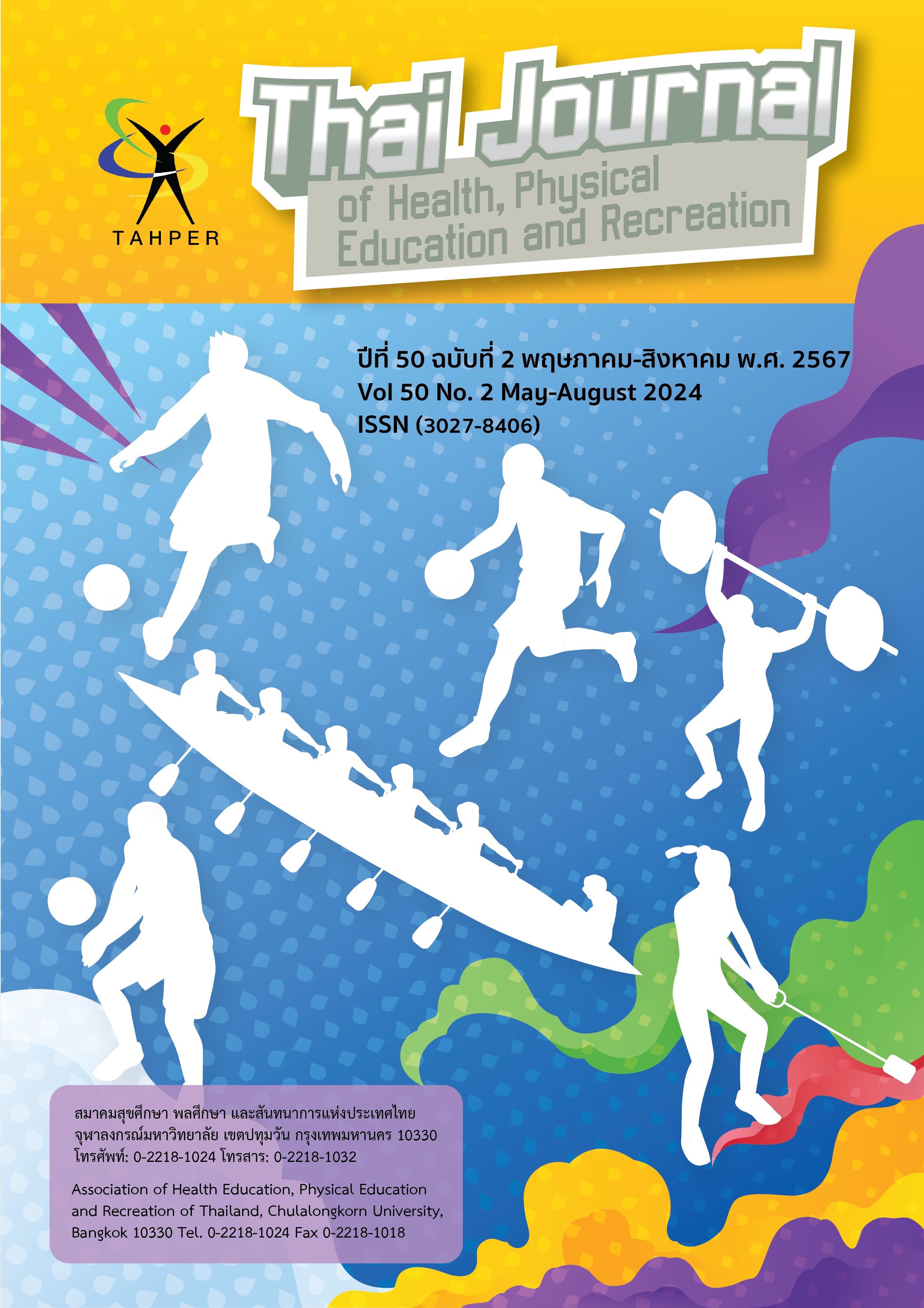The Integration Causal Relationship of Developing Model in Thai Young Elite Swimmers
Main Article Content
Abstract
The purpose of this research were to 1) study the causal relationship of developing model in Thai young elite swimmers and 2) to developing the integration causal relationship model in Thai young elite swimmers. Sample size from 75 clubs (5 subjects each club included 2 coaches, 2 parents and 1 club administrator), the total was 375 subjects. Mixed methods design was used in two steps. The first step was studied the causal relationship model in Thai young elite swimmers by a questionnaire with 53 items and 9 dimensions, The structure equation model with LISREL version 10.1 was used to analyzed. The second step was establishing the integration causal relationship model and assesses the possibility of the model by 7 experts; focus group discussion technique was use collected data. The results showed that;
1. The causal relationship of developing model in Thai young elite swimmers were including 9 model which included 1) management structure and policy; 2) equipment, 3) location and facilities; 4) budget and budget management; 5) welfare and morale of athletes and coaches; 6) coach development program; 7) selection of swimmer to be members and representing clubs for competitive; 8) national and international competitions and
9) sport science and research. Moreover, the effectiveness factors of the 9 model as 6 dimension as follows; 1) member satisfaction; 2) club’s adaptability; 3) club’s efficacy; 4) club’s subsistence; 5) club’s performance and 6) club’s development.
2. The developing of an integration causal relationship model in Thai young elite swimmers should be done by 9 models can lead to assess effectiveness of an integration causal relationship model in Thai young elite swimmers.
Article Details

This work is licensed under a Creative Commons Attribution-NonCommercial-NoDerivatives 4.0 International License.
Critical thinking in journals is the right of the author. The Association of Health Education, Physical Education and Recreation of Thailand is not always required, to create diversity in ideas and creativity.
ความคิด ข้อวิพากษ์ในวารสารเป้นสิทธิของผู้เขียน สมาคมสุขศึกษา พลศึกษา และสันทนาการแห่งประเทศไทยไม่จำเป็นต้องเห็นชอบด้วยเสมอไป เพื่อให้เกิดความหลากหลายในความคิดและความสร้างสรรค์
References
ชาย โพธิสิตา. (2562). ศาสตร์และศิลป์การวิจัยเชิงคุณภาพ. (พิมพ์คั้งที่ 8). กรุงเทพฯ: อมรินทร์พริ้นติ้งแอนด์.
ธนูชัย พัวพันธ์พงษ์, (2563, 11 มิถุนายน). หัวหน้าผู้ฝึกสอนนักกีฬาว่ายน้ำเยาวชนทีมชาติไทย. สัมภาษณ์
พูลพงศ์ สุขสว่าง. (2557). หลักการวิเคราะห์โมเดลสมการโครงสร้าง. วารสารมหาวิทยาลัยนราธิวาสราชนครินทร์
(2), 136-145.
พรพจน์ ไชยนอก และศักดิ์ชาย พิทักษ์วงศ์. (2555). การบูรณาการวิทยาศาสตร์การกีฬาเพื่อการฝึกซ้อมและการแข่งขันในนักกีฬาว่ายน้ำ. วารสารวิชาการของคณะวิทยาศาสตร์การกีฬา จุฬาลงกรณ์ มหาวิทยาลัย, 13(2), 1-17.
วิศท์ เศรษฐกร. (2556). ข้าราชการปฏิบัติการ:ทรัพยากรมนุษย์ กลุ่มสำคัญในการบริหาร. วารสารมหาวิทยาลัยราชภัฎลำปาง, 1(2), 87-97.
สุรวุฒิ มหารมณ์. (2558). มหกรรมกีฬาซีเกมส์เกมส์แห่งมิตรภาพ. กรุงเทพฯ.
สืบสาย บุญวีรบุตร และลัดดา เรืองมโนธรรม. (2558). ระบบการดำเนินการ และปฏิบัติงานในการพัฒนานักกีฬาเป็นเลิศ ของประเทศไทยสู่ความยั่งยืน ต่อเนื่อง และมีประสิทธิผล.วารสารวิทยาศาสตร์การกีฬาและสุขภาพ, 16(3), 1-14.
De Bosscher, V., De Knop, P., Van Bottenburg, M., Shibli, S; & Bingham, J. (2009). Explaining Inter national sporting success: An international comparison of Elite Sport Systems and Policies in six countries. Sport Management Review, 12(3), 113-136.
Ding, L., Velicer, W., & Harlow, L. (1995). Effect of estimation methods, number of indicators per factor and improper solutions on structural equation modeling fit indices. Structural Equation Modeling, 2, 119-143.
Green, M., and Houlihan, B, (2005). Elite Sport Development. Policy Learning and Political Priorities. London and New York: Routledge.
Schumacker, R. E. & Lomax, R. G. (2016). A beginner’s guide to structural equation modelling. 4th ed. New York: Taylor & Francis.


